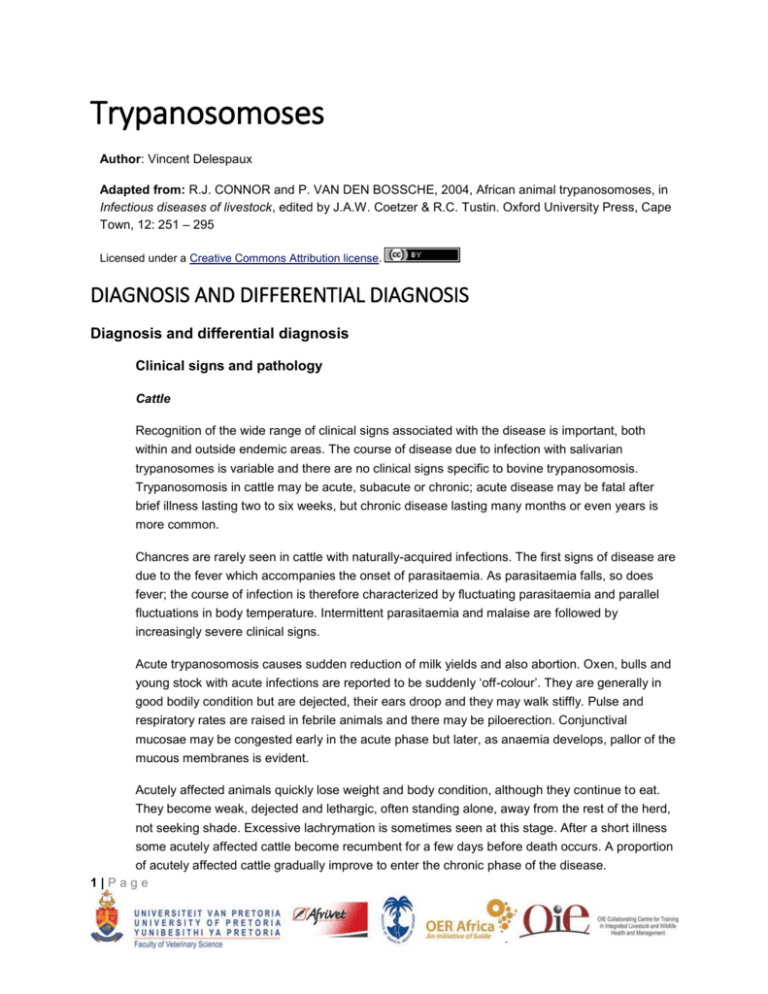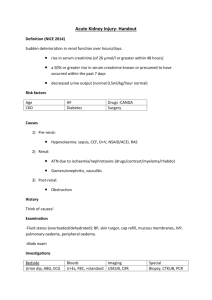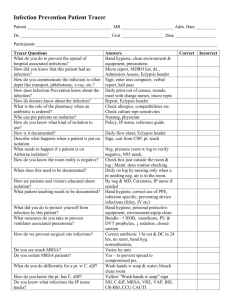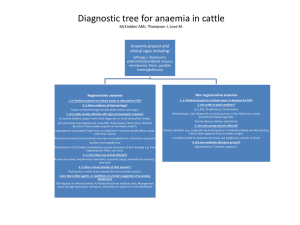trypanosomoses_4_diagnosis
advertisement

Trypanosomoses Author: Vincent Delespaux Adapted from: R.J. CONNOR and P. VAN DEN BOSSCHE, 2004, African animal trypanosomoses, in Infectious diseases of livestock, edited by J.A.W. Coetzer & R.C. Tustin. Oxford University Press, Cape Town, 12: 251 – 295 Licensed under a Creative Commons Attribution license. DIAGNOSIS AND DIFFERENTIAL DIAGNOSIS Diagnosis and differential diagnosis Clinical signs and pathology Cattle Recognition of the wide range of clinical signs associated with the disease is important, both within and outside endemic areas. The course of disease due to infection with salivarian trypanosomes is variable and there are no clinical signs specific to bovine trypanosomosis. Trypanosomosis in cattle may be acute, subacute or chronic; acute disease may be fatal after brief illness lasting two to six weeks, but chronic disease lasting many months or even years is more common. Chancres are rarely seen in cattle with naturally-acquired infections. The first signs of disease are due to the fever which accompanies the onset of parasitaemia. As parasitaemia falls, so does fever; the course of infection is therefore characterized by fluctuating parasitaemia and parallel fluctuations in body temperature. Intermittent parasitaemia and malaise are followed by increasingly severe clinical signs. Acute trypanosomosis causes sudden reduction of milk yields and also abortion. Oxen, bulls and young stock with acute infections are reported to be suddenly ‘off-colour’. They are generally in good bodily condition but are dejected, their ears droop and they may walk stiffly. Pulse and respiratory rates are raised in febrile animals and there may be piloerection. Conjunctival mucosae may be congested early in the acute phase but later, as anaemia develops, pallor of the mucous membranes is evident. Acutely affected animals quickly lose weight and body condition, although they continue to eat. They become weak, dejected and lethargic, often standing alone, away from the rest of the herd, not seeking shade. Excessive lachrymation is sometimes seen at this stage. After a short illness some acutely affected cattle become recumbent for a few days before death occurs. A proportion of acutely affected cattle gradually improve to enter the chronic phase of the disease. 1|Page Subacute trypanosomosis in an ox: the animal has lost weight and condition and it is dejected, with drooping ears and flaccid tail. (Reprinted by kind permission of FGU Consulting and Engineering GmbH, Königstein, Germany, and the Regional Coordinator, RTTCP, Harare, Zimbabwe) In contrast to the acute disease, subacute trypanosomosis is more common and runs a more prolonged course, with many animals apparently making a spontaneous recovery. In subacute cases, animals are intermittently ‘off-colour’, becoming weak and dejected, with drooping ears and flaccid tail. Within a few weeks they lose weight and condition, the coat becomes dull and a marked jugular pulse develops. Superficial lymph nodes and haemal lymph nodes are frequently enlarged and are readily visible. Gradually, the frequency and intensity of parasitaemia decrease and fever subsides. Dependent oedema, particularly in the submandibular region, may develop. Thin, rough-coated, anaemic, lethargic cattle with generalized lymph node enlargement are said to have a ‘fly-struck’ appearance. Death may occur between 4 and 6 months after the onset of disease, but many animals make a gradual recovery, which is assisted by a good plane of nutrition. Chronic bovine trypanosomosis is by far the most common form of the disease in endemic areas. Severely affected cattle may be extremely emaciated, having lost a large proportion of their muscle mass; they are often just ‘skin and bone’. Their general condition is very poor — the hair is sparse and the coat is rough, dull and staring. Mucous membranes are very pale, the pulse is rapid, and breathing is laboured; in resisting restraint, the animal may collapse in respiratory distress after brief exertion. The combined effect of anaemia, circulatory disturbance and 2|Page myocardial damage frequently produces acute cardiac decompensation which leads to sudden death from congestive heart failure. The gross pathology of affected animals varies with the duration and severity of the disease, and many organs and tissues are affected. The overall appearance of the carcass is one of paleness and petechial and ecchymotic haemorrhages are frequently present, especially on serosal surfaces. Lymph nodes are enlarged and, when incised, are oedematous and often have a dark pigmented medullary area. Typically, the spleen is greatly enlarged and dark red. Excessive peritoneal fluid is present which is often blood-tinged. The gross pathology of chronic trypanosomosis is characterized by cachexia and anaemia. The coat is dry and dull, the skin is scaly and inelastic, the eyes sunken and skeletal muscles are atrophied. There is hydrothorax, hydropericardium and ascites, and the carcass, in general, appears oedematous. Residual fat around the heart and kidneys is gelatinous. Lymph nodes, haemal nodes and spleen are generally enlarged and have an appearance similar to that seen in acute trypanosomosis, but after prolonged disease there may be splenic atrophy. The heart is enlarged and flabby, the liver swollen and pale. Whereas red marrow is present in the long bones in acute trypanosomosis, all the bone marrow is yellow and gelatinous in the chronic disease. Gross changes are not always obvious, but microscopic lesions are extensive. These are found particularly in the cardiovascular system and lymphoid tissues, and there is widespread infiltration of many organs by mononuclear inflammatory cells. Dilation of the microvasculature, and oedema and structural changes in vessel walls are usually seen, and trypanosomes are commonly present in the lumens of blood vessels. A constant feature of trypanosomosis is initial hyperplasia of the lymphoid tissues and of the mononuclear phagocytic system. The heart is commonly affected, and macrophages, lymphocytes and plasma cells infiltrate the myocardium. Degenerative changes and focal necrosis of myocytes and, in long-standing infections, fibrosis are evident in the heart. Infiltrations also occur frequently in other organs such as the pituitary, thyroids, adrenals, kidneys and gonads. Congestion and interstitial oedema also occur, and, when the substantia propria is affected, corneal opacity then develops. Sheep and goats The general clinical signs of trypanosomosis of goats and sheep are similar to those in cattle. Acute disease is characterized by intermittent and increasing dullness. During bouts of fever, sick animals walk stiffly, or stand with head held low, ears drooping and tail flaccid. Early morning rectal temperatures may exceed 41 C in the febrile periods, when the pulse is rapid and the breathing shallow and fast. Anaemia develops rapidly and the PCV falls from 0,35 l/ – 0,18 l/ or less in two to four weeks, when mucous membranes become pale. Affected animals rapidly lose weight and condition, and may die within a month of the onset of detectable parasitaemia. The signs of subacute trypanosomosis are less marked, and the course of the infection resembles that in cattle. Chronic infections are very common and may develop without marked clinical signs. Parasites are rarely found in the blood and animals are afebrile. Clinically, it is difficult to 3|Page distinguish such animals from those with helminthosis. Furthermore, the immunosuppression induced by trypanosomosis in goats and in sheep permits the establishment of large helminth burdens, which thus exacerbate the clinical signs in affected animals. The pathology of trypanosomosis in goats and sheep does not differ greatly from that in cattle. A goat with a naturally acquired Trypanosoma vivax infection: prescapular lymph nodes are greatly enlarged Pigs Trypanosoma brucei and T. congolense infections in pigs generally produce only mild disease. Occasionally, anaemia occurs, which is accompanied by loss of condition and progressive weakness leading to incoordination. Trypanosoma suis infections are of minor clinical importance and have only rarely been recorded; infections run a chronic course, but may kill young pigs in less than two months. Trypanosoma simiae infections in pigs eclipse in importance all other trypanosomal infections in this host. This parasite may kill pigs after an incubation period of only four to six days, and infected pigs may collapse and die within 24 hours of the first signs of disease. Affected pigs are dull and inappetant or completely anorexic. They have a stiff, unsteady gait and eventually become prostrate. Dyspnoea is evident and cyanosis may be seen. Some pigs froth at the mouth and there may be diarrhoea. Rectal temperatures reach 41 C but the extremities are usually cold. 4|Page The necropsy findings vary considerably, and there are no pathognomonic changes. The blood is usually cyanotic, clots slowly, and chicken fat clots may be found in the heart. Haemorrhages affect the epi- and endocardium, kidneys and serosal surfaces. The spleen is usually enlarged and the pulp soft with a ‘strawberry jam’ appearance; there is excessive serous or serosanguinous fluid in the pericardial sac and pleural and peritoneal cavities; the trachea may be filled with froth when there is also pulmonary oedema. Thoracic and abdominal lymph nodes are usually enlarged and oedematous, and may be haemorrhagic. Horses and donkeys The general clinical signs resemble those seen in ruminants. Horses with acute trypanosomosis are very dejected. Intermittent parasitaemia occurs and is accompanied by fever; rectal temperatures may reach 40,5 C and there is tachycardia. Oedema of the lower limbs occurs early in the course of disease, as affected horses are less active than normal. Subcutaneous oedema then affects the ventral thorax and abdomen. Oedematous plaques may form on the flanks, but dependent oedema is more pronounced. Weakness sets in rapidly. Initially, mucous membranes may be congested and icteric but they become pale as the disease progresses. The condition of the animal deteriorates rapidly and weakness may progress to paraplegia. Oedema becomes increasingly severe. Animals die within two to four weeks from the onset of clinical signs. Chronic trypanosomosis commonly occurs in horses and donkeys. Animals lose condition and weight and the coat becomes harsh and dry. Animals become extremely weak and show signs of ataxia, but usually continue to eat. Subcutaneous oedema, initially affecting the limbs and ventral abdomen, may extend to the sheath, scrotum, perineum and occasionally the head. The general pathology of equine trypanosomosis resembles that occurring in cattle. 5|Page A horse with a chronic Trypanosoma congolense infection showing emaciation and ventral oedema Dogs The general clinical signs of trypanosomosis in dogs resemble those in livestock, but the course and severity of the disease are modified by the virulence of the parasite and the susceptibility of the host. In acute disease the dog suddenly becomes dejected and inappetant. Pulse rate, respiratory rate and rectal temperature are raised. Anaemia develops rapidly; mucous membranes become pale and the dog shows signs of weakness and depression. There is progressive weight loss; as the condition deteriorates, the coat becomes dry and subcutaneous oedema, particularly of the head and limbs, may develop. Ocular lesions characterize both T. brucei and T. congolense infections but are more severe in the former case. Trypanosoma brucei invades all tissues of the eye, producing blepharitis, conjunctivitis, keratitis and uveitis. Additionally, T. brucei invades many other tissues, and by entering the cerebrospinal fluid causes ataxia and partial paralysis. Death ensues within four to 10 weeks of the onset of signs. Infections with T. congolense generally follow a more protracted course. In chronic cases, dogs become severely emaciated, and ulceration of the oral and gastrointestinal mucosa may develop, leading to haemorrhage and melaena. Inappetance may only be intermittent, with animals being periodically ‘off colour’. 6|Page Lesions of trypanosomosis in dogs are broadly similar to those found in livestock. Anaemia is the most readily detectable change early in the course of infection, and the PCV drops markedly. Whilst T. congolense infections produce extensive interstitial oedema and ulceration of gastrointestinal mucosa, tissue lesions induced by T. brucei are much more severe. There is marked cellular infiltration and cellular degeneration and necrosis. The heart, choroid plexus and eyes are consistently and severely affected. Laboratory confirmation The specific diagnosis of trypanosomosis is notoriously difficult. Not only are there no specific clinical signs, but the intermittent and frequently low parasitaemias make detection of the parasites difficult. Furthermore, infection is not synonymous with disease; many subclinically infected animals live in delicate balance with potentially pathogenic trypanosomes. An element of clinical judgment is, therefore, necessary when making a diagnosis of trypanosomosis. The detection of infection in a few clinically affected cattle warrants careful examination of the entire herd. The only way to confirm diagnosis in clinically infected animals is to demonstrate and identify the parasites in body fluids. The parasite detection methods are highly specific but their diagnostic sensitivity is relatively low. This is especially the case when results are considered for an individual animal rather than in a herd. As a result, the apparent prevalence of trypanosomosis determined by parasitological diagnostic tests is an underestimate of the true parasitological prevalence. This is a problem in areas where the disease is present at low prevalence or is seasonal, or when attempting to confirm the absence of the disease in a particular area. The body fluid most commonly examined is blood, either capillary blood from the tip of the tail or venous blood from an ear vein or from the jugular vein. Lymph, aspirated from a punctured superficial lymph node (usually the prescapular), provides useful supplementary diagnostic material. Wet blood smears are prepared by placing a drop of blood (about 2 µl), taken directly from a punctured ear vein or the tip of the tail, onto a clean, dry, grease-free slide. This is immediately covered with a cover slip and examined microscopically as a fresh, wet preparation with a x25 or x40 objective lens. Approximately 50 to 100 fields are examined. Live, motile trypanosomes may be seen as they bore their way between blood cells (the name “trypanosome” is derived from the Greek “trypanon” a borer and “soma”, meaning body). More commonly, for routine diagnosis in veterinary practice, thick and thin smears of blood are prepared. A drop of blood taken directly from a punctured blood vessel in the ear or tail tip is placed on a glass slide; a thick and a thin blood smear can then be made on a single slide. Lymph smears are prepared in a similar manner. The unfixed de-haemoglobinized thick smear allows approximately 120 times more blood to be scanned than a thin smear and, thus, has higher diagnostic sensitivity than the thin smears. Trypanosomes are easily recognized by their 7|Page general morphology but may be damaged during the staining process. This makes it difficult to make a species-specific identification on thick smears. The thin smear, on the other hand, permits accurate speciation of the parasites. However, due to the staining process, results are delayed. The development of anti-trypanosomal antibody detection techniques has been a major improvement in the serodiagnosis of trypanosomosis. The indirect immunofluorescent antibody test (IFAT) has been and still is used widely to diagnose trypanosomosis. The test has undergone several modifications so that it can differentiate, to a limited extent, between trypanosome species in ruminants. The serodiagnosis of trypanosomosis has greatly benefited from the introduction of enzyme immunoassays. The ELISA compares favourably with the IFAT and has been found to give results that correlate with the local history of trypanocide usage. However, even if a trypanosomal infection has been cured, anti-trypanosomal antibodies persist for several months and antibody detection tests do not distinguish between current and past infections. They can only provide a presumptive diagnosis. A polymerase chain reaction (PCR) method has been developed for the diagnosis of infections with African trypanosomes in humans, animals and tsetse flies. Specific repetitive nuclear DNA sequences can be amplified for T. vivax and each of the three T. congolense subgroups. A common primer set is available for detection of the three T. brucei subspecies. Despite the development of more sensitive, more sophisticated and expensive diagnostic methods the clinician will, for the foreseeable future, have to rely upon examination of blood smears, buffy coat preparations and findings at necropsy to confirm diagnoses of trypanosomosis. The diagnosis of trypanosomosis in small ruminants is no different from that already discussed for cattle, but it is much more difficult because of the larger proportion of subclinical infections. In these cases very low parasitaemias occur in the absence of obvious clinical signs. It is undoubtedly these factors which are responsible for the serious underestimation of trypanosomosis in small ruminants. Differential diagnosis In its various stages bovine trypanosomosis resembles a number of other disease conditions, and it frequently occurs at the same time as other infections. In the acute febrile stage, bovine trypanosomosis must be differentiated from redwater (babesiosis), anaplasmosis and East Coast fever. The haemorrhagic syndrome in acute T. vivax infection can be distinguished from anthrax and haemorrhagic septicaemia (Pasteurella multocida infection) by examination of Giemsa-stained blood smears, when large numbers of trypanosomes are found. The main disease entity which resembles trypanosomosis in goats and sheep is helminthosis, especially haemonchosis. Anaemia, illthrift, weight loss, submandibular oedema and high mortality rates are common to the two disease complexes, although diarrhoea sometimes accompanies helminthosis. 8|Page A history of sudden death in a number of pigs, combined with clinical signs as described, is suggestive of T. simiae in areas adjacent to tsetse infestations. Other causes of sudden death that should be differentiated include African and European swine fevers and anthrax. Chronic trypanosomosis in pigs should be differentiated from helminthosis and malnutrition. Acute disease in horses and donkeys must be distinguished from African horsesickness, anthrax and babesiosis. In chronic trypanosomosis the oedema has to be differentiated from that occurring in African horse-sickness and the anaemia from that of equine infectious anaemia. Chronic babesiosis may also produce signs similar to chronic trypanosomosis. The signs of weight loss, emaciation and oedema caused by dourine (T. equiperdum infection), strongylosis, malnutrition and dental disorders should be differentiated from those caused by salivarian trypanosomes. The anaemia in dogs caused by trypanosomosis must be differentiated from that arising from infection with Ancylostoma caninum, Babesia canis or Ehrlichia canis. Hookworm infection may be concurrent with trypanosomosis. Bilateral corneal opacity produced by trypanosomosis must be distinguished from that seen in canine hepatitis (adenovirus-2 infection). 9|Page






